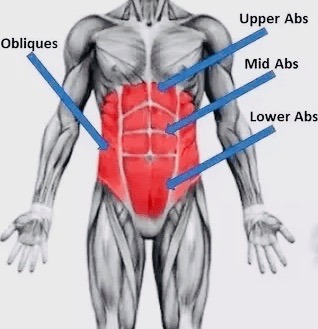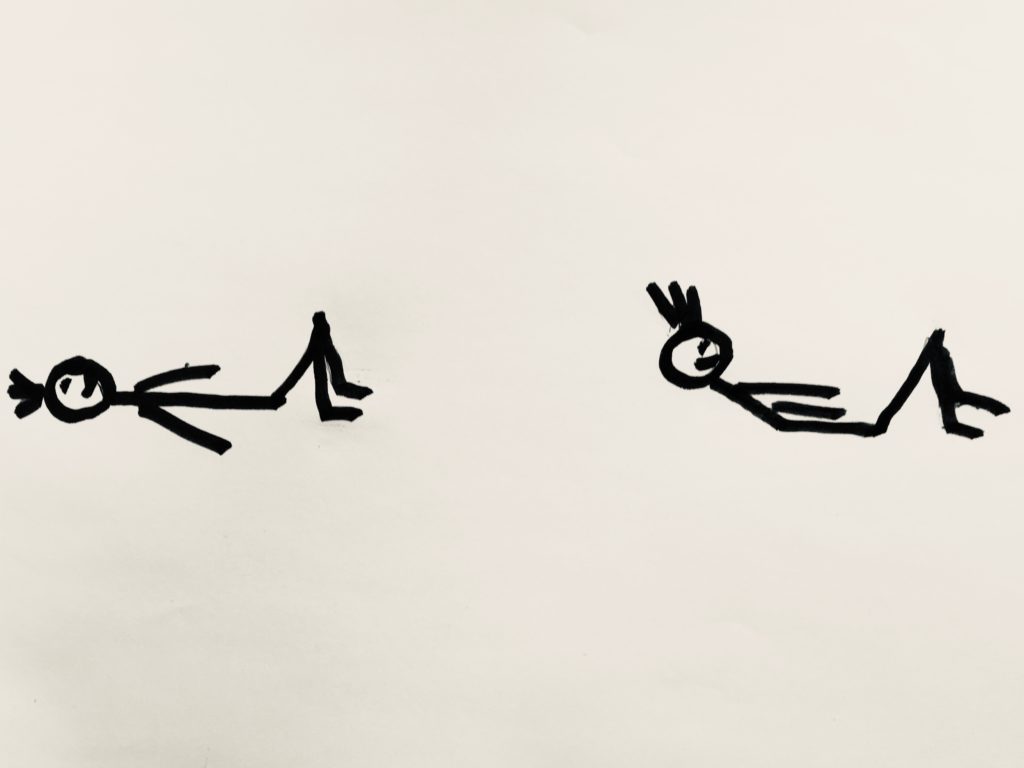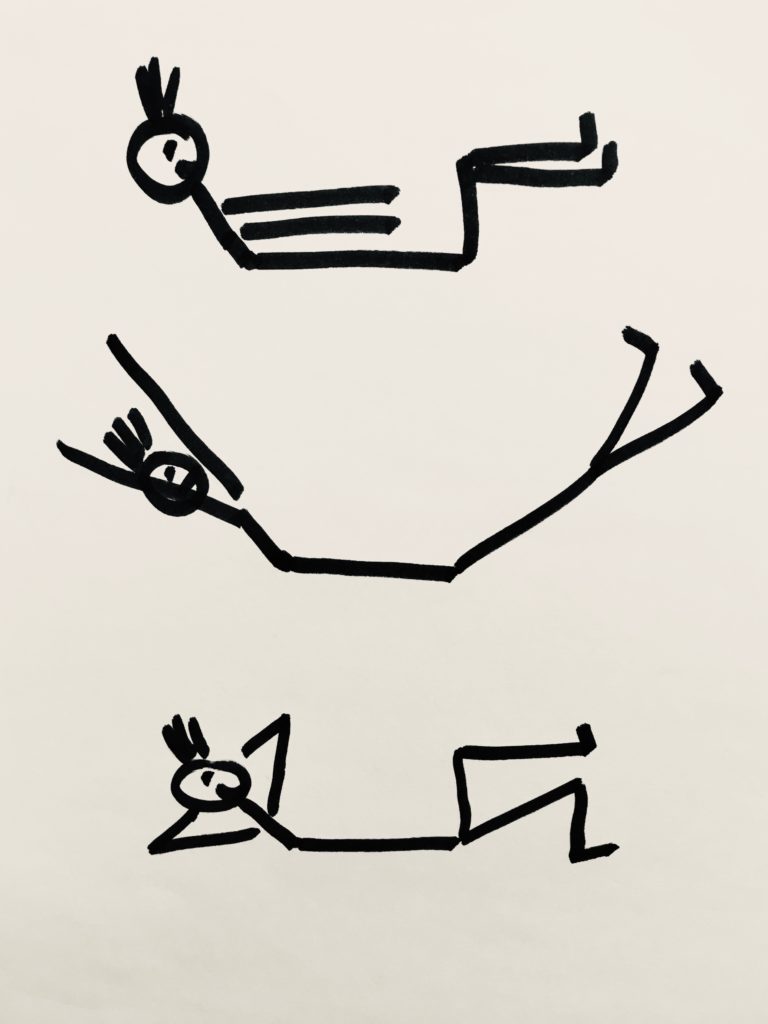The other day, on a visit to my parents, I looked out onto the big balcony. There hangs a Baltic souvenir: A wooden fish – not a whole fish (like for example these here), but only the skeleton, made of pieces of wood.
Anyway – while I looked out and looked at the fish (and again felt a hint of longing for the sea), a little titmouse came flying to it, hung with its feet on one of the bones, dangling upside down at first (apparently with great joy), before it pulled the body up again so that it could peck the bone with its beak.
Jeez – I thought – not bad, this crunch! And what perfect technique! 😀
For us humans it may not be a technically challenging exercise – but the crunch of this tit was a small masterstroke! Therefore, I take it as an opportunity to provide a crunch technique tutorial here.
The crunch is an isolated abdominal muscle exercise. Isolated means that only one muscle group is trained – in traditional crunching, these are the upper and middle straight abdominal muscles (from chest height to slightly above the navel). As an isolated exercise, the crunch is not very high on the list of our “must-do’s”, but it is well suited at the beginning of the training to warm up the core and slowly get the circulation moving.
Execution
You lie on your back, your legs are usually angled, your feet are firmly on the ground. Now lift your shoulders off the floor by activating the upper and middle abs and pulling your shoulders towards your legs. Gently place the fingertips against the temples, cross the forearms on the chest or stretch the arms towards the heels. When the shoulder blades have completely left the ground, you have reached the highest point of your crunch and slowly lower them down to the ground again.
You can increase the level of difficulty by doing the crunch “upside down” – like the little titmouse – e.g. lying on a staircase or slope, with the head down and the feet up. 😛 In this case the legs are usually stretched.
There are only two things you really need to pay attention to.
- Pull your chin to your chest. Think of the tit that “rolls up and in” so beautifully. That’s what you want to do. That’ll take the pressure off your neck. You don’t want to pull from the neck, you want to pull from the abs. Sometimes I see my participants making a veeeeeeery long neck and trying to lift their nose up to the ceiling… Just by watching I have neck pains. For the same reason please never fold your hands in your neck, because then you’ll pull on your neck and/or head again.
So chin to chest and look straight ahead through the legs, not to the ceiling. - The lower back always remains on the ground. You achieve this by tightening your abs firmly and pulling your belly button towards your spine. Otherwise you risk getting into a hollow back position, which can damage your back.
So tense your stomach, pull your belly button towards your spine and always keep your lower back in contact with the ground.
By the way, 1000 crunches a day won’t give you a six-pack: Even if you’re one of the lucky ones whose tendons divide the abs into the highly sought-after “packs”, a simple isolated exercise like the crunch isn’t enough. No, for this you need functional combination exercises – especially recommended are for example hover or plank – and a very low body fat percentage.
But if you want to have alternatives to hover and plank in your training plan, you can pimp the crunch with the following three variations:
- C-crunch:
In the C-crunch, you raise your legs at the same time you lift your shoulders. This means that the lower straight abdominal muscles and the hip flexor are now also trained, making this exercise “functional training”. Many people make the mistake of simply lifting their lower legs from their knees. You avoid this by keeping the angle in your knees the same, deliberately pulling your thighs over your hips (and here they stay, they don’t go further to the chest) and keeping your lower legs parallel to the floor (feet at the same height as your knees). So in the upper end position you have a 90° angle in the hip and a 90° angle in the knees. When lowering you don’t just let your feet “fall down”, but keep the angle in your knees the same and lower your legs in a strong, controlled way. Of course, the above technical instructions also apply to the C-crunch. - Shoot-out:
This is a kind of opposite movement to the C-crunch in which you don’t make yourself small, but rather long. The starting point is the upper end position of the C-crunch – so the knees are above the hip, the lower legs are parallel to the floor and both shoulder blades are raised. Then slowly stretch your arms and legs to 45° (the end position is the hollow body) before bending in again. You can put your shoulders and head down on the ground or keep them slightly raised (then the upper abdominal muscles have to work harder). Important: The shoot-out is only suitable for athletes with already well trained abs, because the danger of getting into the hollow back is much greater with the long lever than with a crunch or C-crunch. So make sure that your lower back always stays on the ground! If you can do that, the shoot-out is a great functional exercise that strengthens the whole core. - Cross-crawl:
Thanks to a twist, the oblique abs are now involved. In the cross-crawl you lift one shoulder and at the same time the opposite knee (technique as described above in the C-crunch), thus turning alternately the right shoulder to the left knee and the left shoulder to the right knee. Usually the fingertips are at the temples – make sure that the upper elbow stays outside, so that really the shoulder goes to the knee and not the elbow, for otherwise you just move the arm and do not work out of the abdomen. Again, the lower back remains firmly on the floor, so that you turn in the middle of the chest, and the chin of course remains on the chest.
The great thing about all these exercises is that you don’t need any equipment and you can do them anytime, anywhere.
Do you also want to get as fit as the little titmouse and make crunches upside down (maybe not dangling from a bone)?
Well then off to the studio and get FIBERED straight away! 😀
Then subscribe to our blog updates via the sidebar (in the mobile version via the + sign). If you also want to be able to comment on our posts, just register here.





